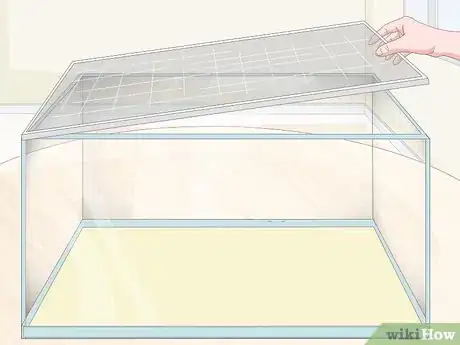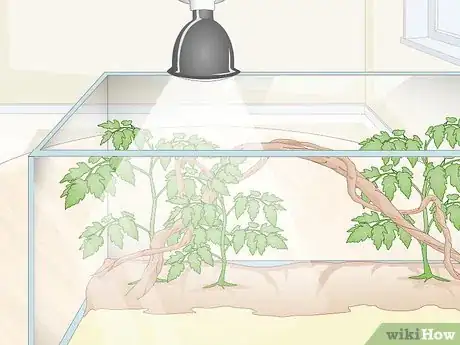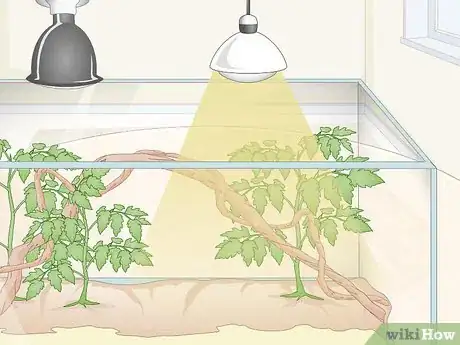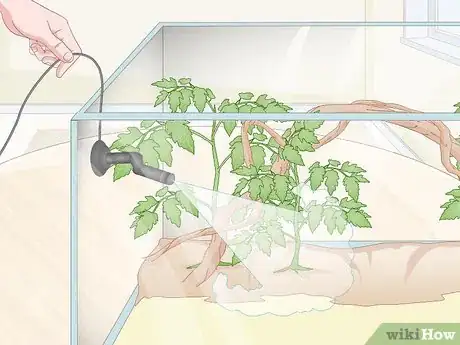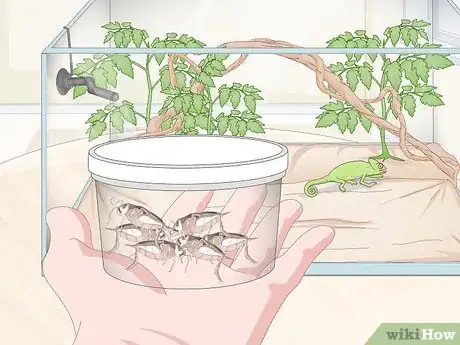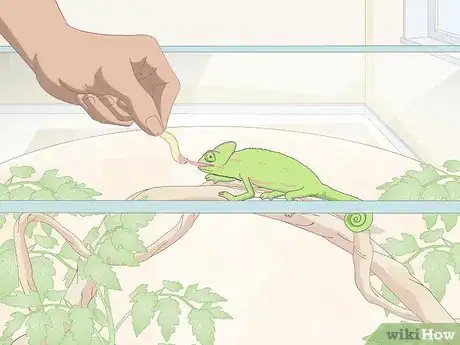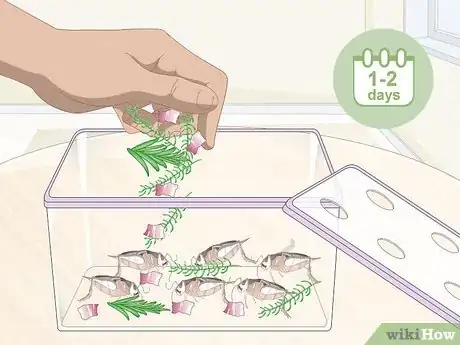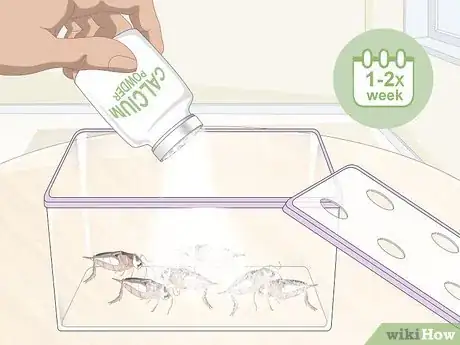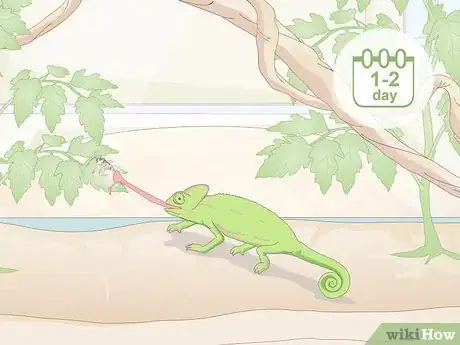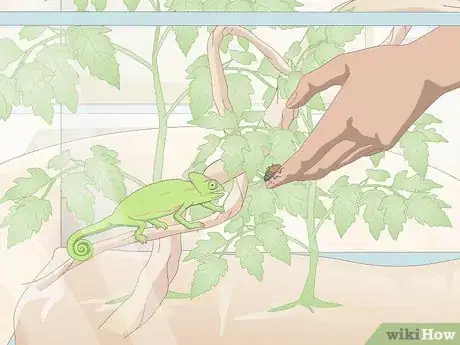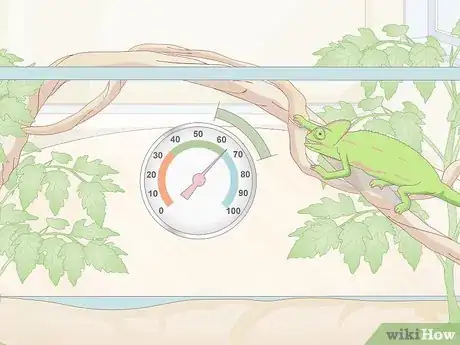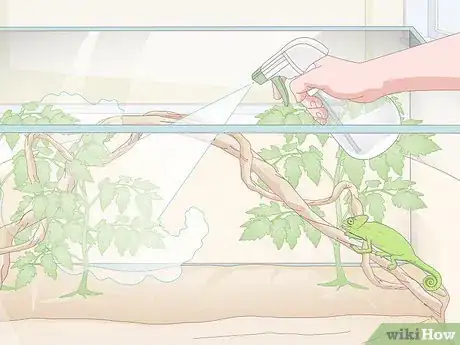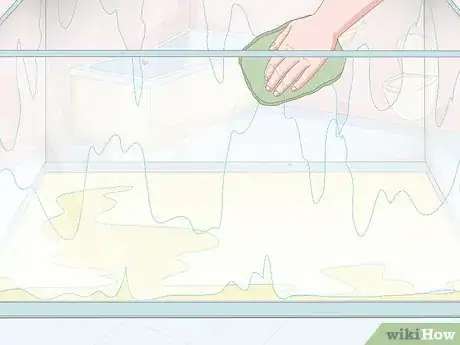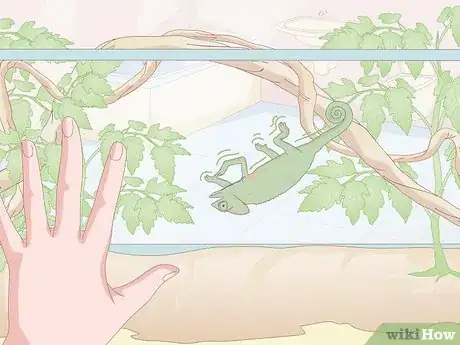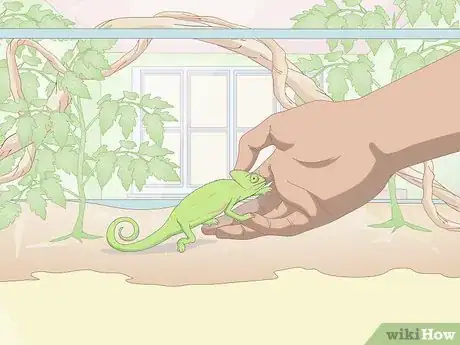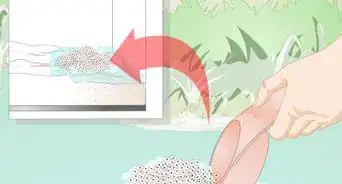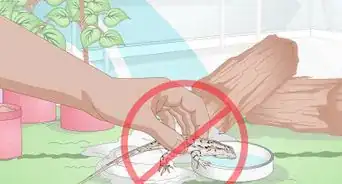This article was co-authored by Jaime Nalezny, DVM. Dr. Jaime Nalezny is an exotic animal veterinarian with over 15 years of experience, focusing on the care of birds, reptiles, amphibians, and exotic small mammals. Dr. Nalezny founded The Iguana Relocation Network and is on the board of directors for Midwest Avian Adoption & Rescue Services. She graduated from the University of Minnesota College of Veterinary Medicine in 2005.
There are 15 references cited in this article, which can be found at the bottom of the page.
wikiHow marks an article as reader-approved once it receives enough positive feedback. This article received 20 testimonials and 85% of readers who voted found it helpful, earning it our reader-approved status.
This article has been viewed 715,306 times.
Chameleons are fascinating pets, but they are high maintenance and you need to care for them properly to keep them happy and healthy. Proper care includes setting up and maintaining an enclosure appropriate for the species you have and taking care of its basic needs. In addition to a clean and controlled environment, chameleons need regular nutrition and proper health care. If you are able to manage all of these things, your chameleon is likely to live a healthy life.
Steps
Setting Up Your Chameleon's Home
-
1Purchase or build a reptarium. A reptile’s cage is called a reptarium. It is typically a glass tank with a mesh top on it or a wire cage. For a chameleon that's 1 foot (0.30 m) or less in length, you need a reptarium that is at least 2 feet (0.61 m) wide by 3 feet (0.91 m) deep by 3 feet (0.91 m) tall. Choose the largest enclosure you can to give your chameleon plenty of space.[1]
- You can use an aquarium, a wire pet cage, or even a bird cage as your reptarium.
- Set up a reptarium for each of your chameleons. Chameleons are solitary animals. They don't like other chameleons.
- Juvenile chameleons can grow quite a bit, so make sure you have enough space for a chameleon perhaps twice the size of the one you bought!
Tip: Only when chameleons are babies do they feel comfortable with other chameleons. Once they are a year old, they should be separated. However, sometimes they start fighting with each other when they are even younger than that.
-
2Put plants and climbing limbs in the cage. These are key to making your new pet comfortable in its new home. You can use either real plants or fake plants. Pathos and ficus are good choices. Climbing limbs can either be real wood or synthetic, but be sure to choose hardwood species that don't produce sap if you choose real limbs. Place them in such a way that your chameleon can climb up to the upper areas of the cage.[2]
- Plants and climbing limbs that are appropriate for your reptarium can be purchased at pet stores and from online retailers.
- Veiled chameleons usually need more vegetation than other species of chameleons.
Advertisement -
3Provide the chameleon with a heat lamp. Buy a heat lamp made for reptariums at your local pet store or online retailer and put it at the top of the tank. This will allow the chameleon to come up and bask in the heat if it wants some warmth, but it can also come down if it gets too hot. Keep the enclosure between 77 and 87 °F (25 and 31 °C) during the day and 65 and 75 °F (18 and 24 °C) at night.[3]
- It’s okay if the reptarium drops to 72 °F (22 °C) during the day and 50 °F (10 °C) at night for veiled chameleons.
- Jackson’s chameleons like basking spots that are 85–90 °F (29–32 °C), but the ambient air temperature can range between 55–58 °F (13–14 °C).[4]
- Buy a pet-safe thermometer to go inside the cage. This will allow you to make sure the temperature is right. You can also use a laser thermometer to check the temperature from outside of the cage.
- Chameleons like it colder at night, so the heat lamp can be on a timer that turns it off at night.
-
4Get a good-quality UV-B light. In addition to the heat lamp, get another light that will light the rest of the reptarium and will give your chameleon key nutrients. Chameleons need 12 hours of UV-B light per day to utilize calcium and prevent metabolic bone disease. Keep the UVA/UVB light inside the enclosure rather than outside any mesh or glass.[5]
- These lights are available at pet stores and from online pet-supply retailers. Replace your UV-B light every 6 months.
- You can buy bulb output monitors online or from pet stores to help measure how effectively it’s working in the reptarium.
- Time outside basking in the sun is another way for your chameleon to get Vitamin D.
-
5Keep the humidity between 50 and 70%.[6] Install a moisture system in the reptarium, or manually mist with a spray bottle. Moisture systems are available in drip or mist systems made specifically for reptariums. Both are available at pet stores and online.[7]
- There is a wide range of misters and drip systems to choose from. For instance, you can get misters and drip systems that have a reservoir tank that you fill every week or 2 that sits outside of the reptarium. These are cheaper and easier to set up than misting systems that are attached to a water source all of the time, in addition to needing water plumbed to the location of your tank for those systems.[8]
- Keep a hygrometer in the tank, which measures the humidity levels. Try to find one with a history function so you can check previous humidities to make sure they stay within the correct levels. You can also use a pump sprayer or spray bottle to help increase the humidity.
- Misting systems are usually more expensive than drip systems. They can also be hard to set up if you get one that needs to be attached to a water source.
- Whether you get a mist or drip system, be sure that it has a built-in timer.
-
6Line the bottom of the reptarium with newspaper or paper towels. Newspaper and paper towels work well in chameleon tanks because they absorb the animal’s waste and can be replaced easily and cheaply. Put down several layers of newspaper or paper towels on the bottom of the cage and change it every few days.[9]
- Paper on the floor of the enclosure will also help maintain humidity. The paper will work well but shredded coconut husks can be added to increase moisture retention.
Feeding Your Chameleon
-
1Buy your chameleon crickets. The most common purchased food for chameleons is crickets. You can buy them at your local pet store or they can be purchased online.[10]
- You will only feed your chameleon a few crickets at a time and crickets don't live long, so only buy a week or 2 worth of crickets at a time.
- Baby chameleons need very small crickets. They also like and can survive off of fruit flies.
- If you’re raising feed crickets or insects for your chameleon rather than buying them, feed them vegetables high in calcium and vitamin A so they’re more nutritious for the chameleon.[11]
-
2Supplement your chameleon’s diet with other insects. You can purchase other insects for your chameleon, such as wax worms, mealworms, super worms, flies, moths, and grasshoppers. These are nice treats and give the chameleon a well-balanced diet.[12]
- In addition to store-bought bugs, you can give the chameleon bugs, spiders, and moths from your house or garden. A mixed diet is good.
- Veiled and Jackson’s chameleons will need more supplementary insects since crickets aren’t a good as a sole source of nutrients.[13]
Tip: Avoid feeding your chameleon bees, wasps, fireflies, and other stinging insects.
-
3Gut-load the crickets for a day or 2 before feeding them to your chameleon. This simply means the crickets need to be fed a nutritious diet, which in turn helps your chameleon to get the nutrients it needs. Feed your insects well so they can feed your chameleon well with a food that is made for gut feeding.[14]
- Gut-feeding food is available at most pet stores and from online retailers.
- Underfed insects will not give your chameleon all of the nutrients it needs.
-
4Dust the crickets before each feeding. The crickets should be covered in calcium powder right before they are put in your chameleon’s tank. This helps the chameleon get its calcium when it eats the bug. Dusting is done by gently shaking the crickets in a small plastic bag that contains calcium powder.[15]
- Buy calcium powder at your local pet store or online retailer.
- The calcium powder will have specific directions, including how much powder to use, on its label.
-
5Feed your chameleon a cricket or two every day. Simply place the crickets loose in the tank with your chameleon. Allow your chameleon to hunt the crickets down itself.[16]
- Make sure that you put the lid on securely after putting the crickets in the tank. Crickets have a habit of sneaking out of unsecured lids.
-
6Replace one of the crickets with a different insect once every few days. While crickets should be the majority of your chameleon’s diet, giving it a few other insects will vary its diet. It will also stimulate its mind and give it something new to hunt.[17]
Keeping Your Chameleon Healthy
-
1Measure the humidity level in the enclosure daily with a hydrometer. If the humidity is below 50%, adjust the misting or water system to keep the chameleon comfortable. Humidity over 80% can be too high as well, leading to mold and fungus growth. Reduce the amount of moisture you put in the tank if this occurs.[18]
- Each chameleon species has different humidity requirements, so check what the tolerable humidity levels are for the species you have so you can make adjustments as you need to.
- Low-cost humidity meters, or hygrometers, are available at pet stores and from online retailers. You may also be able to find one that connects to a smartphone so you can easily track the humidity levels.
- If you see your chameleon licking objects in its tank, that is likely because it is thirsty and looking for dew to lick.
-
2Spray or mist the enclosure daily. Set your drip or misting system to go off automatically or use a spray bottle to add moisture to the reptarium. You can use a spray bottle from any store to spray the water on the leaves in your enclosure. This increases humidity and enables your chameleon to drink as well.[19]
- Don’t spray the chameleon's body directly.
- You can buy a pressure sprayer if you like. Get one at your local hardware store. It lets you spray a very fine mist.
Tip: Use a brand new, clean spray bottle that you only use for your chameleon’s water. Using one that has been used for cleaning products or another chemical in the past can be fatal to your pet. Buy a new one from any store.
-
3Establish a relationship with a vet who treats reptiles. Do an online search for vets in your area or contact one that you already know of. Ask them if they have experience treating reptiles. Pick the one that you like the best and schedule an introductory appointment.
- You can find veterinarians that specialize in reptiles online at the Association of Reptile and Amphibian Veterinarians website.
- If there are few veterinarians in your area, it may not be easy to find one that has experience treating reptiles. However, you may be able to find one that is willing to learn how to treat exotic pets.[20]
- It’s important to know who to go to if your chameleon gets sick or needs preventative veterinary treatment. Don't get stuck and not know where to go with a sick reptile.
-
4Do a light cleaning of the tank every day. Remove any extra food at the bottom of the cage every day in order to keep parasites and bacteria from developing. Also, replace wet bedding and remove any fecal matter that you see on the surface of the bedding or on plant leaves and limbs.[21]
- Doing light cleaning every day will help keep your chameleon’s home clean. However, it doesn't replace deep cleaning of all of the surfaces.
-
5Clean your chameleon’s tank from top to bottom every week. Move the chameleon to a holding tank and remove all of the plants and accessories from the enclosure. Dispose of the substrate and wipe down the entire enclosure with warm, soapy water. Clean the accessories as well. Then, disinfect everything with a household disinfectant. Rinse the enclosure and accessories with plain water, then dry them. Once the enclosure is totally dry, put in fresh substrate and replace the accessories.[22]
- Alternatively, use something naturally disinfectant like vinegar and baking soda. Scrub the surfaces with this mixture and then use hot water and rinse it off well.
Tip: Remove the chameleon from the enclosure while you clean it. Putting your chameleon in a secondary holding tank with a perch will ensure that it won't be disturbed and that you won't have to work around your chameleon while you clean.
-
6Keep an eye out for signs of illness. Chameleons change color when cold, stressed out, or sick. If you see this happening, take your pet to get looked at by a vet. Other signs of illness that require veterinary care include:[23]
- Not moving
- Acting strangely
- Not eating
- Skin abnormalities
- Swollen body parts
- Falling off branches
- Growth abnormalities
- Shivering, twitching, or tremors
- Swollen or closed eyes
- Weight loss and weakness
- Difficulty shedding
- Inability to launch its tongue fully
Ensuring That Your Chameleon is Happy
-
1Put your reptarium in a calm, warm room. Chameleons are very easily stressed and they need a serene environment. Your chameleon will be perfectly happy to be kept in an isolated location that doesn’t have a lot of traffic, such as a bedroom or office. In that room, pick a warm spot that gets lots of diffused light.[24]
- A warm room is especially important if you have a wire cage reptarium, since the cage has no insulation.
- Keep the tank away from cold windows when it's cold outside.
Tip: Chameleons do not interact well with other pets. Do not force them to interact with dogs, cats, ferrets, or any other pets. Keep your chameleon in a room away from other pets.
-
2Take your chameleon outside to bask in the sun. This is a way to get the UV-B light that a healthy chameleon needs. Not only do chameleons love basking in the sun, but it also keeps them healthy! Make sure the temperature is warm enough outside for your chameleon and stay with it the entire time to protect it. Also, make sure there is a shady spot the chameleon can move to if it gets too warm.[25]
- Make sure that you keep a hold of your chameleon while you have it outside. It’s best to put it in a travel reptile carrier so that it doesn’t escape.
- Keep the chameleon on your hand or in a wire enclosure so you don’t block the beneficial sunlight.
- Even 15-30 minutes a week outside can benefit your chameleon, but they still need proper lighting in their enclosure.
-
3Handle your chameleon with care. Chameleons are sensitive animals that need to be treated delicately. Don't force your chameleon out of its cage or do anything else that may stress it. Instead of grabbing your chameleon, allow it to crawl onto your hand or a perch inside its enclosure if it wants to. Chameleons generally see humans as predators, so many of them don't like to be handled. Don't attempt to "play" with your chameleon on a regular basis—you should only handle it when moving it out of its cage for cleaning, outdoor time, or veterinary care.[26]
Things You'll Need
- Reptarium/enclosure
- Thermometer
- Hygrometer
- Food
- Basking lights
- UV lights
- Misting and humidity control system, if needed
- Spray bottle
- Plants for climbing, either real or fake
- Substrate
- Holding tank
- Cleaning supplies
References
- ↑ https://chameleoncare.net/cage-habitat/
- ↑ http://www.avianandexotic.com/care-sheets/reptiles/care-of-chameleons/
- ↑ http://www.avianandexotic.com/care-sheets/reptiles/care-of-chameleons/
- ↑ http://www.exoticpetvet.com/jacksons-chameleon-care.html
- ↑ http://www.avianandexotic.com/care-sheets/reptiles/care-of-chameleons/
- ↑ https://chameleoncare.net/cage-habitat/
- ↑ https://www.chameleonforums.com/care/water/
- ↑ http://www.reptilesmagazine.com/Reptile-Care-For-Beginners/Reptile-Enclosures-and-Set-Ups/Reptile-Misting-Systems/
- ↑ https://chameleoncare.net/cage-habitat/
- ↑ https://static1.squarespace.com/static/5706bdd507eaa0b8239942b7/t/597ba9fed482e99ee45d7d8d/1501276671373/Panther_Chameleon_Care-Aurora_Animal_Hospital.pdf
- ↑ http://www.anapsid.org/crickets.html
- ↑ https://chameleoncare.net/food-diet/
- ↑ http://www.exoticpetvet.com/jacksons-chameleon-care.html
- ↑ https://chameleoncare.net/food-diet/
- ↑ https://static1.squarespace.com/static/5706bdd507eaa0b8239942b7/t/597ba9fed482e99ee45d7d8d/1501276671373/Panther_Chameleon_Care-Aurora_Animal_Hospital.pdf
- ↑ https://www.animalspot.net/panther-chameleon.html
- ↑ https://chameleoncare.net/food-diet/
- ↑ https://www.animalspot.net/panther-chameleon.html
- ↑ https://www.chameleonforums.com/care/water/
- ↑ https://www.chameleonforums.com/care/health/vet/
- ↑ https://chameleonacademy.com/maintenance-cleaning-your-chameleon-cage/
- ↑ https://chameleonacademy.com/maintenance-cleaning-your-chameleon-cage/
- ↑ http://www.avianandexotic.com/care-sheets/reptiles/care-of-chameleons/
- ↑ http://www.avianandexotic.com/care-sheets/reptiles/care-of-chameleons/
- ↑ http://www.reptileknowledge.com/care/chameleon-sunshine.php
- ↑ https://chameleonacademy.com/basics-handling-chameleons/
- ↑ http://www.muchadoaboutchameleons.com/2012/05/on-specific-care-of-females.html
About This Article
To take care of a chameleon, start by setting up a tall cage with mesh ventilation, plants, and branches. Add a thermometer, an analog humidity meter (hygrometer), and a heat lamp to ensure the temperature and humidity stay at the correct levels. Once or twice a day, feed your chameleon live crickets, worms, or other bugs, which you can purchase at most pet stores. To give your chameleon water to drink and maintain humidity in the cage, spray the leaves or the side of the tank with water based on the requirements of the species you have. For tips on interacting with your chameleon and cleaning its enclosure, keep reading!
